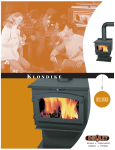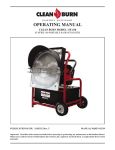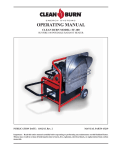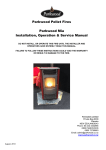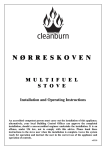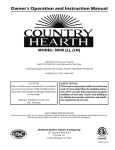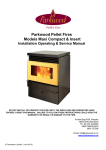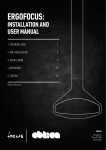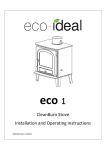Download Operating Instructions - Heritage Building Centre
Transcript
Pedestal Models: Insert Models: FS 500 LE IS 500 LE FS 800 LE IS 800 LE Operating Instructions Efficient—Warm—Friendly Keep instructions in a safe place for future reference Do not throw away Pecan Engineering Pty Ltd proudly supports the activities of Landcare Australia through its membership of the AHHA USER INSTRUCTIONS 1. INTRODUCTION AIR CONTROLS Before use of this appliance please read these instructions fully. WARNING: ANY MODIFICATION OF THE APPLIANCE THAT HAS NOT BEEN APPROVED IN WRITING BY THE TESTING AUTHORITY IS CONSIDERED AS BREACHING AS/NZS 4013. WARNING: DO NOT USE FLAMMABLE LIQUIDS OR AEROSOLS TO START OR REKINDLE THE FIRE. WARNING: DO NOT USE FLAMMABLE LIQUIDS OR AEROSOLS IN THE VICINITY OF THIS APPLIANCE WHEN IT IS OPERATING. WARNING: DO NOT STORE FUEL WITHIN HEATER INSTALLATION CLEARANCES. Cleanburn technology and greater efficiency The Nectre Free-standing FS range and Insert IS range feature a single air control system. It is designed to introduce oxygen to into the base of the fire thereby controlling the rate of combustion of the wood as well as oxygen being drawn into the upper firebox where combustion of the gases occurs. The air control is operated by sliding the spring handle located on the top left side of the heater. Pulled all the way out offers maximum burn rate, while pushed all the way in offers minimum burn rate. Secondary air holes in the rear of the firebox provide additional oxygen for more complete combustion of the gases released from the burning wood. WARNING: WHEN OPERATING THIS APPLIANCE AS AN OPEN FIRE USE A FIRE SCREEN. WARNING: OPEN AIR CONTROL (AND DAMPER WHEN FITTED) BEFORE OPENING FIRING DOOR. CAUTION: THIS APPLIANCE SHOULD NOT BE OPERATED WITH A CRACKED GLASS. CAUTION: THIS APPLIANCE SHOULD BE MAINTAINED AND OPERATED AT ALL TIMES IN ACCORDANCE WITH THESE INSTRUCTIONS. DOOR HANDLE Warning: door handle may get hot if appliance has been left in High burn setting for an extended period of time. In which case use a protective glove or equivalent to open. Open air slide before opening the door to eliminate the chance of backdraft and/or smoke entering the room. CAUTION: THE USE OF SOME TYPES OF PRESERVATIVETREATED WOOD AS A FUEL CAN BE HAZARDOUS. The appliance or flue system should not be modified in any way without the written approval of the manufacturer. FAN The can be used to spread the heat around the room more quickly and into other rooms. It does not have to be on if not required. Extractor fans or cooker hoods must not be placed in the same room or space as this can cause appliance to emit smoke into the room. 2. USING APPLIANCE FOR FIRST TIME First few times the appliance is lit, it will give off some odorous fumes. This is caused by the paint curing. Do not touch the paint work while it is curing otherwise it can leave a permanent mark on the appliance. Once the paint has cured it will not re-occur. Keep the room well ventilated until these fumes have cleared. 3. RECOMMENDED FUELS Burn only seasoned hardwood timber with a moisture content of less than 20%. Newly cut wood should be allowed to dry/season for 12 to 18 months before use. Wood should be stored in an environment protected from the weather to minimise any potential moisture content. For best results, wood should not exceed 270mm in length and 150mm diameter. Any larger and appliance will not operate at its optimum. It is better to burn several smaller pieces of wood than one large single piece. 5. RUNNING THE APPLIANCE Maximum Heat Output: After establishing the fire and loading it with larger pieces of wood, leave it running with the air slide fully open (pulled all the way out). This setting will generate maximum heat output. Running the appliance with the door open will not produce maximum heating in the room as it will draw a lot of already warmed air out of the room. Do not overload firebox with fuel. Note that this setting is not the most energy efficient as some heat is lost up the flue instead of being transferred into the room. However, once fire has established, particulate emissions will be very low, i.e. no smoke, which is good. To further maximise heat output turn the fan on to the High speed setting to spread the heat around the room. Poor quality timber: - Causes low combustion efficiency - Produces poor emissions (smokey) - Results in additional build up of creosote (soot) in the flue which will then require regular cleaning and may result in a flue fire. Do not burn painted, impregnated/treated wood, manufactured board products or pallet wood. Low Heat Output: The heat output on the appliance can be reduced by closing the air slide which will restrict the oxygen supplied to the fire and slow down the rate at which the wood burns. This setting will provide the best energy efficiency as the wood burns for longer. However, if not operated correctly may result in higher particulate emissions. Prior to closing the air slide ensure that the fire is burning briskly. This may require opening the air slide fully for 5-10mins before shutting down. 4. LIGHTING THE FIRE Place firelighters or paper and dry kindling wood in the base of the firebox. Light the paper or firelighters. Open the air control located on the top left corner of the appliance by pulling out from the appliance. If necessary, leave the door slightly open as the fire establishes and the glass warms to avoid the build-up of condensation. For the optimum between clean burning, and getting the best in efficiency, from the fully closed position, open the air slide 4-5mm. Add larger pieces of wood. Too many logs may smother the fire. Close the door. The air slide can be adjusted to any position so desired depending on wanted heat output versus burn time. Do not leave fire unattended while door is not closed. Fan may be turned to Low speed setting or off if the heater is putting out sufficient heat without the fan on. Reload with more wood: Factors affecting the flue draught include: 1. Open air slide before opening door. Insufficient flue height 2. Rake / break up any existing coals. Trees or other buildings nearby causing turbulence 3. Load the wood with the length orientated front to back. High and gusty winds 4. Better results will be achieved by loading several smaller pieces of wood than one large piece. Outside temperature and weather conditions Blocked flue 5. Close door with air slide fully open, and leave for minimum of 10 minutes to allow the fresh wood to catch. 6. After 10 or more minutes, the air slide can be adjusted to the desired heat output setting. 6. BURNING TIPS Fuel Quality Use wood with a moisture content of less than 20%. Logs should not feel moist or damp, or have moss and fungal growths. For advice on the correction of persistent flue problems consult your supplier/installer for more detail. 7. ASH REMOVAL Depending on the type of wood burnt and frequency, the ashes will need removing every 2 to 6 weeks. Excess ashes should be removed when necessary, placed in a non-combustible container with a tightly fitting lid and moved outdoors immediately to a location clear of combustible materials. Symptoms related to wet wood: 8. FLUE/CHIMNEY FIRE Difficulty starting and keeping a fire burning well Smoke and only small flames Dirty glass and/or fire bricks Shut air slide control fully to smother the fire Rapid creosote build-up in the flue/chimney Low heat output Do not use the appliance after a flue fire until an accredited installer has assessed the cause and any resultant damage. Short burn times, and blue/grey smoke from the flue/chimney outlet Run appliance at high heat output for a short period each day to avoid large build-up of tars and creosote within the appliance and flue. If a flue/chimney fire occurs: 9. CLEANING PAINT WORK & GLASS The appliance, when cool, can be cleaned with a damp cloth. Over the years, the black paint will fade and can be touched up with Stove Bright metallic black paint. To clean the glass, we recommend using a household window cleaner or general purpose cleaner with a soft cloth. Do not use abrasive cleaner or scourer pads. Flue Draught The flue has two main functions:1. 2. To safely remove smoke, gases and fumes from the appliance. To provide a sufficient amount of draught (suction) in the appliance to ensure the fire keeps burning. Draught is caused by the rising hot air in the flue when the fire has been lit. The position, height and size of the flue can affect the performance of the flue draught. Refer to installation guide for details on flue installation. 10. CLEANING THE FLUE Check inside of flue prior to each season for any build up of creosote (wood tar). To do this:o First remove the baffle (refer to “2. Replacement of Baffle” under Maintenance & Servicing section). o Using a small mirror and torch hold the mirror on an angle below the flue with the torch shining at it and look for black creosote build up. If only a fine black powdery layer then that is normal, but if built up layers of creosote can be seen, then the flue needs cleaning. o Refit the baffle if no cleaning is required. 11. TROUBLESHOOTING TIPS 1. This can have several possible causes: i) Burning unseasoned wood — if the wood is too wet, it will cause the glass to blacken. ii) Appliance operated at low temperature — after an overnight burn where the air slide control has been fully closed, the glass may have blackened. When the fire is re-stoked and burning on the high heat setting, the blackened glass should self-clean. iii) Problems with the flue — insufficient flue draught can cause the glass to blacken. If the flue is too short, not properly insulated, or in a position that results in a downdraught, then there will be insufficient flue draught. Contact the installer should this happen. 2. Trouble starting the fire — if all ash has been removed from the firebox, then it can upset the supply of air to the base of the fire. It can aid the fire by retaining some ash when cleaning out the firebox. 3. Glass cracking — Do not over tighten the screws on the stainless steel strips that hold the door glass in place. Otherwise, expansion of the cast iron door may cause the glass to crack. To clean the flue:o A flue cleaning brush can be purchased from most wood heater retail outlets or large hardware stores. o The objective is to pull the brush down through the flue. o With the baffle removed, tie a rope to one end of the brush, and drop the rope from the top (outside on top of the roof) down the flue. o Grab the end of the rope inside the firebox and pull the brush through. o Check the inside of the flue with the mirror and torch. Repeat if necessary. o Once clean, remove any excess creosote from the firebox and replace the baffle. Alternatively, get a flue cleaning service to do the job for you (it’s a dirty job). Check flue integrity by checking that the 900mm flue sections have not separated at the joins. Glass in door blackening MAINTENANCE and SERVICING 1. REPLACEMENT OF FIREBRICKS 2. REPLACEMENT OF BAFFLE The purpose of the firebricks in the appliance is to increase thermal mass and to guarantee the longevity of the steel firebox. Over time the firebricks may become cracked and crumble away. If so, then they should be replaced soon after. The 8mm thick steel baffle helps to retain the heat in the firebox by lengthening the path of the flame so that they do not go straight up the flue. To replace the firebricks: Over time, the baffle will begin to sag a little due to the excessive heat. This will not affect the way the fire burns. i) Move any ash away from the base of the bricks. Eventually the baffle will burn through (5+ years) and if so will need to be replaced. ii) Remove the brick retainer(s) and remove the bricks. To remove the baffle: iii) Replace with new bricks, and retainers which hold the bricks in place. i) ii) iii) FS 500 LE & IS 500 LE – Brick Layout iv) v) vi) Remove any excess ash and coals. Remove the brick retainers and bricks from the rear and sides of the firebox. Lift the baffle up at the back enough to clear the rear support pegs and slide forward so that the baffle can be lowered at the back. Lowering the rear of the baffle will allow the front of the baffle to slide past the front support pegs on the sides of the firebox. Once the baffle has cleared the front support pegs, it can be removed from the firebox. Repeat steps i) to v) in reverse to replace with the new baffle. Note: The FS 800 LE and IS 800 LE baffle weighs 14kg, some strength is required to replace the baffle. FS 800 LE & IS 800 LE – Brick Layout 3. REMOVING THE DOOR iii) iv) To remove the door:i) ii) iii) iv) Unscrew the air control slide rod. Remove the door-stop screw from the bottom left corner. Lift the door up and over the top end of the vertical hinge rod. Lower the door and slide off the bottom end of the hinge rod. (Note that sometimes the bottom horizontal panel with the “Nectre” decal may be hindering the door from sliding off the bottom end of the hinge rod. If so, then the bottom panel can be removed by lifting it up and off from the heater body, it hangs on two lugs.) v) Keeping the door in that position relative to the hinge, open it and tighten the screws until firm. Close the door to 90% again and make any final adjustments up or down by tapping the door on the right hand side until it appears parallel relative to the top and bottom horizontal panels above and below the door. Open door again and tighten screws fully. 5. FITTING A NEW DOOR GLASS This task may be easier with the door removed from the appliance and laid horizontally on a work-bench. To replace the door glass: 4. ADJUSTING THE DOOR Over time the screws securing the door hinge plate to the heater may loosen resulting in the door dropping, i.e. visually appears on slight angle and no longer 100% horizontal. This can result in a poor door seal and unnecessary amounts of oxygen entering the firebox and wood burning too quickly. i) Remove the three M8 size Allen key screws securing the glass retainer to the door with the supplied Allen key. ii) Lift the left hand side of the glass retainer about 5mm, then slide the retainer across to the left so as to free it from the two hinge brackets on the right hand side. iii) Gently lift the glass retainer up and out, taking careful note that the glass may still be intact in the retainer and potentially could fall out. iv) Flip the retainer over, remove the old glass panel. v) The new door glass panel should have been supplied with a length of adhesive glass seal. Peel back the backing on the tape, and run it along the edges of the glass panel, folding it equally over each side so as to create a padded border around the edge of the glass. vi) Fit the new glass into the glass retainer, and fit the retainer back into the door ensuring that the retainer is secured beneath the two brackets on the right side before fastening the three screws. To fix this and reposition the door:i) ii) With the supplied Allen key, loosen the two screws on the hinge plate. With the door 90% closed, slowly lift the bottom right corner of the door until the door appears horizontal. b. Remove the T-shaped latch and remove one washer. c. Replace the latch and then place the remove washer over the rod. d. Refit the nut. Do not over tighten otherwise door handle will not turn easily. If door seal is still not tight enough remove another washer or replace door seal. vii) Dispose of the old glass in a responsible manner. 6. FITTING A NEW DOOR SEAL This task may be easier with the door removed from the appliance and laid horizontally on a work-bench. i) Remove any old seal from the door. ii) Clean out the groove in the door that the seal was bedded in using a flat-end screw driver or equivalent. 8. REPLACEMENT SPARE PARTS LIST 1. Firebricks 500 Series 6 @ 1 @ 3 @ 800 Series 10 @ 235mm 235mm 235mm 285mm x x x x 175mm x 25mm 140mm x 25mm 85mm x 25mm 175mm x 25mm 2. Baffle Plate iii) Run a thin bead of clear roof and gutter silicone along the groove. 500 Series 490mm x 230mm x 8mm (10kg) 800 Series 590mm x 286mm x 8mm (14kg) iv) Starting at one end, press the new door seal into the groove on the door. 3. Ash Deflector v) 500 Series 495mm x 130mm x 5mm 800 Series 595mm x 130mm x 5mm Refit the door if it has been removed and close. 4. Door Seal 7. DOOR HANDLE ADJUSTMENT 500 Series 1300mm x 16mm round 800 Series 1900mm x 16mm round 5. Glass Seal Over time, the door seal can become compressed resulting in a less than adequate seal between the door and the front edge of the firebox. For example, if the wood burns unusually fast even with the air slide shut, it may mean that there is an air leak around the door. In this situation, the door seal does not necessarily need replacing rather adjustment of the door handle can tighten the seal. There are two ways to tighten the door:i) Adjust door latch rod – the rod on the right side of the firebox upon which the door handle latches onto can be gently tapped with a hammer. The rod only needs to be moved 1mm or less, which is a very gently tap. Too much and the rod will need to be levered out again. Close the door to test if any improvement in the door closing firmly. ii) Remove washer from door handle assembly – a. Remove the nut from the door handle shaft inside the door. 500 Series 1550mm x 19mm x 3mm flat adhesive back 800 Series 1840mm x 19mm x 3mm flat adhesive back 6. Brick Retainer Brackets 500 Series 2 x corner brick retainers 4 x flat brick retainers 800 Series 2 x corner brick retainers 4 x flat brick retainers 7. Door Glass 500 Series 483mm x 253mm x 5mm pyroceramic 800 Series 583mm x 303mm x 5mm pyroceramic








